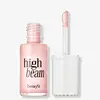What's inside
What's inside
 Key Ingredients
Key Ingredients

 Benefits
Benefits

 Concerns
Concerns

 Ingredients Side-by-side
Ingredients Side-by-side

Water
Skin ConditioningDimethicone
EmollientCyclopentasiloxane
EmollientButylene Glycol
HumectantCyclohexasiloxane
EmollientPolyacrylamide
Polysorbate 60
EmulsifyingEthylhexyl Methoxycinnamate
UV AbsorberC13-14 Isoparaffin
EmollientC9-11 Pareth-6
EmulsifyingTocopheryl Acetate
AntioxidantEthylhexyl Palmitate
EmollientEthylhexylglycerin
Skin ConditioningDisodium EDTA
Benzophenone-3
UV AbsorberBHT
AntioxidantPhenoxyethanol
PreservativeMica
Cosmetic ColorantCI 77891
Cosmetic ColorantIron Oxides
Water, Dimethicone, Cyclopentasiloxane, Butylene Glycol, Cyclohexasiloxane, Polyacrylamide, Polysorbate 60, Ethylhexyl Methoxycinnamate, C13-14 Isoparaffin, C9-11 Pareth-6, Tocopheryl Acetate, Ethylhexyl Palmitate, Ethylhexylglycerin, Disodium EDTA, Benzophenone-3, BHT, Phenoxyethanol, Mica, CI 77891, Iron Oxides
Water
Skin ConditioningCaprylic/Capric/Succinic Triglyceride
EmollientMica
Cosmetic ColorantPentylene Glycol
Skin ConditioningPolymethyl Methacrylate
Dimethicone
EmollientLimnanthes Alba Seed Oil
Skin ConditioningDimethicone PEG-7 Phosphate
CleansingTrimethylsiloxysilicate
EmollientHydroxyethyl Acrylate/Sodium Acryloyldimethyl Taurate Copolymer
Emulsion StabilisingPhenoxyethanol
PreservativeSteareth-21
CleansingSqualane
EmollientCaprylyl Glycol
EmollientSteareth-2
EmulsifyingTocopheryl Acetate
AntioxidantPolysorbate 60
EmulsifyingSodium Stearoyl Glutamate
CleansingButylene Glycol
HumectantSorbitan Isostearate
EmulsifyingSodium Hydroxide
BufferingCI 12085
Cosmetic ColorantCI 15850
Cosmetic ColorantCI 15985
Cosmetic ColorantCI 19140
Cosmetic ColorantCI 42090
Cosmetic ColorantCI 45380
Cosmetic ColorantCI 45410
Cosmetic ColorantCI 73360
Cosmetic ColorantCI 77891
Cosmetic ColorantCI 77163
Cosmetic ColorantCI 77491
Cosmetic ColorantCI 77492
Cosmetic ColorantCI 77499
Cosmetic ColorantCI 77742
Cosmetic ColorantWater, Caprylic/Capric/Succinic Triglyceride, Mica, Pentylene Glycol, Polymethyl Methacrylate, Dimethicone, Limnanthes Alba Seed Oil, Dimethicone PEG-7 Phosphate, Trimethylsiloxysilicate, Hydroxyethyl Acrylate/Sodium Acryloyldimethyl Taurate Copolymer, Phenoxyethanol, Steareth-21, Squalane, Caprylyl Glycol, Steareth-2, Tocopheryl Acetate, Polysorbate 60, Sodium Stearoyl Glutamate, Butylene Glycol, Sorbitan Isostearate, Sodium Hydroxide, CI 12085, CI 15850, CI 15985, CI 19140, CI 42090, CI 45380, CI 45410, CI 73360, CI 77891, CI 77163, CI 77491, CI 77492, CI 77499, CI 77742
 Reviews
Reviews

Ingredients Explained
These ingredients are found in both products.
Ingredients higher up in an ingredient list are typically present in a larger amount.
Butylene Glycol (or BG) is used within cosmetic products for a few different reasons:
Overall, Butylene Glycol is a safe and well-rounded ingredient that works well with other ingredients.
Though this ingredient works well with most skin types, some people with sensitive skin may experience a reaction such as allergic rashes, closed comedones, or itchiness.
Learn more about Butylene GlycolCi 77891 is a white pigment from Titanium dioxide. It is naturally found in minerals such as rutile and ilmenite.
It's main function is to add a white color to cosmetics. It can also be mixed with other colors to create different shades.
Ci 77891 is commonly found in sunscreens due to its ability to block UV rays.
Learn more about CI 77891Dimethicone is a type of synthetic silicone created from natural materials such as quartz.
What it does:
Dimethicone comes in different viscosities:
Depending on the viscosity, dimethicone has different properties.
Ingredients lists don't always show which type is used, so we recommend reaching out to the brand if you have questions about the viscosity.
This ingredient is unlikely to cause irritation because it does not get absorbed into skin. However, people with silicone allergies should be careful about using this ingredient.
Note: Dimethicone may contribute to pilling. This is because it is not oil or water soluble, so pilling may occur when layered with products. When mixed with heavy oils in a formula, the outcome is also quite greasy.
Learn more about DimethiconeMica is a naturally occurring mineral used to add shimmer and color in cosmetics. It can also help improve the texture of a product or give it an opaque, white/silver color.
Serecite is the name for very fine but ragged grains of mica.
This ingredient is often coated with metal oxides like titanium dioxide. Trace amounts of heavy metals may be found in mica, but these metals are not harmful in our personal products.
Mica has been used since prehistoric times throughout the world. Ancient Egyptian, Indian, Greek, Roman, Aztec, and Chinese civilizations have used mica.
Learn more about MicaPhenoxyethanol is a preservative that has germicide, antimicrobial, and aromatic properties. Studies show that phenoxyethanol can prevent microbial growth. By itself, it has a scent that is similar to that of a rose.
It's often used in formulations along with Caprylyl Glycol to preserve the shelf life of products.
Polysorbate 60 is used to help stabilize products. It is a surfactant and emulsifier. These properties help keep ingredients together in a product. Surfactants help reduce surface tension between ingredients with different states, such as liquids and solids. Emulsifiers help prevent oils and waters from separating.
Polysorbate 60 is sorbitol-based and created from the ethoxylation of sorbitan. Ethoxylation is a chemical reaction used to add ethylene oxide. Sorbitan is a the dehydrated version of sorbitol, a sugar found in fruits.
In this case, the 60 comes from reacting 60 units of ethylene oxide with sorbitan.
Polysorbates are commonly used in medicine and foods.
Learn more about Polysorbate 60Tocopheryl Acetate is AKA Vitamin E. It is an antioxidant and protects your skin from free radicals. Free radicals damage the skin by breaking down collagen.
One study found using Tocopheryl Acetate with Vitamin C decreased the number of sunburned cells.
Tocopheryl Acetate is commonly found in both skincare and dietary supplements.
Learn more about Tocopheryl AcetateWater. It's the most common cosmetic ingredient of all. You'll usually see it at the top of ingredient lists, meaning that it makes up the largest part of the product.
So why is it so popular? Water most often acts as a solvent - this means that it helps dissolve other ingredients into the formulation.
You'll also recognize water as that liquid we all need to stay alive. If you see this, drink a glass of water. Stay hydrated!
Learn more about Water